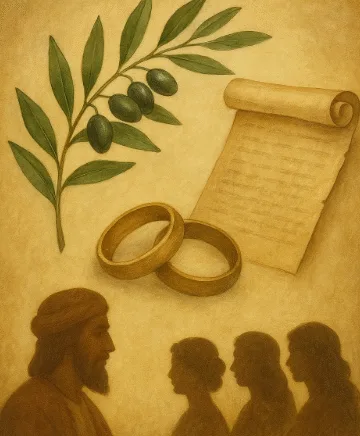In the Old Testament, several key figures—Abraham, Jacob, David, and Solomon—took multiple wives. At first glance, this seems at odds with the Genesis ideal of one man and one woman (Gen. 2:24). To understand why polygamy appears in Scripture, it is important to distinguish between God’s ideal for marriage and the cultural accommodations made under the old covenant.
Cultural Context of the Ancient Near East
Marriage customs in ancient Mesopotamia and Canaan frequently included polygyny (one man, multiple wives). Such arrangements served social and economic functions: they increased a family’s labor force, secured political alliances, and ensured offspring for inheritance (Walton, 2006). When the patriarchs lived, God did not immediately abolish these longstanding practices but instead worked within the existing culture to guide His people toward His original design.
God’s Ideal vs. Descriptive Accommodation
From creation, God’s intention for marriage was monogamous and lifelong (Gen. 2:24). However, after the Fall, human sinfulness led to “hardness of heart” (Matt. 19:8). Under Mosaic Law, God regulated polygamous practices—protecting the rights of wives and children—without endorsing them as His perfect will. For example, Deuteronomy 21:15–17 requires that a man’s firstborn receive his legal inheritance even if born to a less‑loved wife. These regulations demonstrate God’s concern for justice within a broken system.
Is It a Sin to Be a Second Wife?
Progressive Revelation and Accommodation
The Bible unfolds God’s will progressively. In the patriarchal period, God often “accommodated” human weakness to advance His larger redemptive plan (1 Cor. 13:9). Polygamy was never presented as an ideal but allowed temporarily so that God’s purposes—such as the promise of numerous descendants through Abraham—could be fulfilled despite cultural constraints (Gen. 17:4–6).
Consequences and Narrative Critique
Scripture does not shy away from depicting the problems polygamy caused. Rivalries between Sarah and Hagar, Jacob’s household discord, and the tragic outcomes in David’s and Solomon’s families all serve as implicit critiques of multiple‑wife arrangements (Gen. 16; 29–30; 2 Sam. 12; 1 Kgs. 11). These narratives highlight the emotional and social fallout when God’s ideal pattern is set aside.
New Testament Fulfillment of the Ideal
With the coming of Christ, the full intention of monogamous marriage is reaffirmed (Matt. 19:4–6). The New Testament nowhere commands polygyny and explicitly requires church leaders to be “the husband of one wife” (1 Tim. 3:2). These teachings point back to creation and signal the close of the period of cultural accommodation.
Conclusion
God allowed polygamy in the Old Testament not because it aligned with His perfect will but because He chose to work within the cultural realities of fallen humanity. Through regulation, narrative critique, and progressive revelation, Scripture moves readers toward the divine ideal of lifelong, exclusive, one‑man‑one‑woman marriage.
References
New International Version Bible. (2011). Zondervan.
Walton, J. H. (2006). Ancient Near Eastern thought and the Old Testament: Introducing the conceptual world of the Hebrew Bible. Baker Academic.

